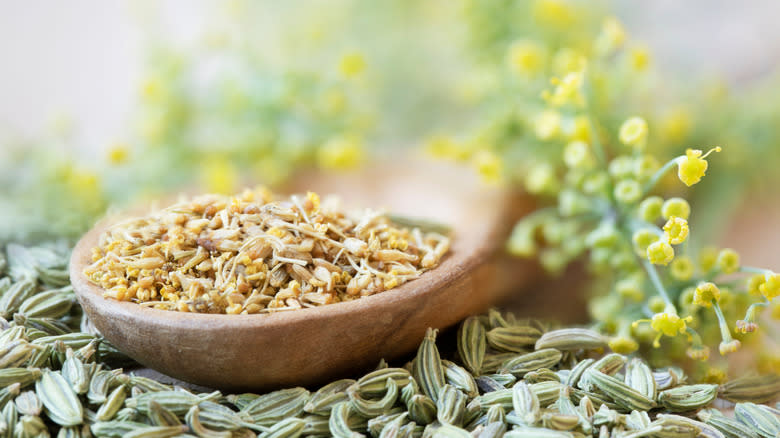Fennel Pollen Is A Little-Known Powerhouse Ingredient For Nearly Any Dish

The right kinds of spices and seasonings can make or break a dish. If you want a meal that truly stands out, then consider sprinkling fennel pollen on top. The ingredient has been referred to by chefs and home cooks as "the spice of angels" and "culinary fairy dust". Fennel pollen has a potent taste that enhances a dish's natural flavors, making it something of a secret ingredient that can wow your dinner guests.
"It carries a complex flavor complete with notes of citrus, saffron, and anise, which often work to complement and not overpower a dish," Olivia Roszkowski, a teacher at the Institute of Culinary Education, told Martha Stewart. Fennel pollen has a summery, airy flavor similar to anise or citrus. It's a versatile spice that can be used with sweet and savory dishes, making it perfect for dinner and dessert.
Fennel pollen adds earthiness and a subtle sweetness that helps elevate a dish without overwhelming other ingredients. However, fennel pollen works best when used with simpler dishes that are a bit pared down. Introduce too many ingredients, and you risk overpowering the spice and leaving it mute. Since fennel pollen is so versatile, you're probably wondering why it's not a common staple in many people's spice racks. Its price may play a factor.
Read more: French Cooking Tricks You Need In Your Life
How Fennel Pollen Is Harvested

Fennel pollen ranks among the most expensive spices that you will find on the market. For instance, one online supplier sells 1 ounce of fennel pollen for $32, which is low compared to other retailers. It can also be difficult to find, with the spice often being out of stock at major retailers like Walmart. Its high price point is due to the complexity of harvesting the spice. Fennel pollen comes from the fennel bulb, specifically its flower blossoms.
Fennel, however, isn't the easiest crop to farm, with experts facing difficulties in cultivating the plant. As such, the best place to find fennel is in the wild. The plant typically grows in Mediterranean regions, where harvesters pick the plant for both its seeds and pollen. Making a difficult situation even more challenging, fennel has very little pollen, meaning you'll need an abundance of the plant to get a proper yield.
Fennel pollen and fennel seeds are similar in taste. So, in the absence of pollen, it's possible to add crushed fennel seeds to something like a meat rub. However, fennel seeds aren't quite as potent as pollen and don't have the same balance. But, although expensive, a little fennel pollen goes a long way, and it can be used in a variety of dishes.
Dishes To Include Fennel Pollen In

As mentioned earlier, the great thing about fennel pollen is its versatility. The spice can be used to enhance a large variety of dishes. For instance, it works particularly well with pork and poultry heightening the meat's natural savoriness. Add some pollen to your roasted vegetables to bring the entire meal together. For meat, you can combine fennel pollen with salt and other spices to create a dry rub. Add it to your meat before cooking to let it permeate deep into the flesh.
Sprinkle some fennel pollen into your soup to give it an earthy kick. In particular, tomatoes and eggplants work well with the spice. Add a little to gnocchi with escarole, speck, and sweet onions. Speaking of vegetables, a sprinkle of fennel pollen heightens the vibrance of a salad, adding a nice herbal finish. Combine a small amount with vinegar and oil to make a floral vinegarette for your leafy greens and vegetables.
When it comes to desserts, fennel pollen makes for a bold choice. Since the taste is similar to anise, you may get a flavor that reminds you faintly of black licorice. It will add a nice contrast if you pair the spice with something particularly sweet, like a custard. And if you're into the unconventional, consider adding a layer of fennel pollen to the rim of your glass to heighten the complexity of your cocktail.
Read the original article on Daily Meal.